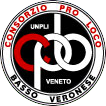
Bonavigo is 35 km south-east of Verona, on the left bank of the river Adige. Its surface is of 17.79 km² and its fractions are Orti and Pilastro. Its territory suffered several modifications because of the several floods and the changes of the Adige’s flow. In Bonavigo, fed by large water pumps, the minor river “Terrazzo” originates; it brings water to the surrounding farmlands. It borders the Comuni of Roverchiara, Albaredo d’Adige, Veronella, Minerbe and Legnago.
ETYMOLOGY
Probably of Roman origins, the burg’s name is recorded in documents form 953 and 1041 with the name of Longbardic derivation Vicus Bonadi Cus, referencing the place where the Adige forks. One of its minor ramifications is called “Fossa Chirola” and is responsible for the serious flood known as “Breach at Cucca”. The town’s name’s origins are still uncertain and some believe that it comes from the Longobardic name Botanucu Boto.
HISTORY
Bonavigo’s origins are very ancient and there are documents dated 887 chronicling that the land was at that time inhabited. Furthermore, tombs and gravestones discovered on the territory confirm the presence of a former Roman settlement. The Barbaric invasions and the intense floods of the river Adige repeatedly interfered with the life of the inhabitants of this rural area, especially throughout the middle ages. Only after the river flow was finally arranged, stabilised, rerouted and canalised by the Benedictine friars, the territory acquired its contemporary setting. As part of the Holy Roman Empire, Bonavigo as well became object of concessions from several Emperors to their trusted bishops, monasteries and vassals. Around the 1000s, two castles were built in today’s town square. Around Ciusara was built the Camaldolese Church of San Michele of Murano. In 1145, Pope Eugenio III granted to “Curtem Bonadigui”, Corte Bonavigo, permission to build a Church and collect tithes. At the time of the Scaligeri, the town constituted an independent Deanery, it was then conquered by Ezzelino da Romano, and it became part of Angiari under the Serenissima Repubblica di Venezia, constrained to a marginal role in the historical events that involved the nearby towns. In 1894 was built a metal bridge on river Adige, to connect Bonavigo and Roverchiaretta, becoming a military objective during the Second World War. Later destroyed, as every other building on the riverbanks, it was built again in 1961 with five arches in reinforced concrete, allowing the village to quit an inconvenient isolation. The new parish, which substituted the old church destroyed by the bombings, was opened in 1956.
ART

Around Pilastro there is the late Renaissance compound of Villa Buri, accessed through a baroque portal. In Bosco, on the banks of the river Adige, there is shrine of the 1500s with a depiction of the “Madonna delle Grazie”. In the district of Orti there is a noteworthy altarpiece of 1575, signed by “Surdis Opus” and placed upon the main altar of the parish of Sant’Andrea, entirely rebuilt in neo-romanesque fashion. And always in Orti there is Villa Fantoni, another historical palace, property of the monastery of Santa Caterina di Venezia from the 1685 to the early 1800s.
ECONOMY
Bonavigo’s economy is mainly founded upon agriculture. Strawberries, melons and vegetables are grown in greenhouses and their farming is quite relevant, like the production of apples, pears, corn, sunflower, soy and wheat. There are also cow and chicken farms. Several industries and craftsmanship businesses have recently spawned in Bonavigo, stimulating the growth of the local economy.
